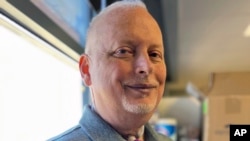A man in the Northeastern state of Massachusetts has regained his voice after a rare operation.
Marty Kedian received a total transplant of his larynx, the organ responsible for speech, commonly called the “voice box.”
Transplants of the larynx are very unusual and normally are not available to people with active cancer. Kedian is only the third person in the United States to receive a total larynx transplant. Doctors removed Kedian’s cancerous larynx and replaced it with a donated one.
Surgeons at the Mayo Clinic in Arizona offered Kedian the transplant as part of a new study. The study, known as a clinical trial, aims to open the operation to more patients, including some with cancer, the most common way to lose a larynx.
“People need to keep their voice,” 59-year-old Kedian told the Associated Press four months after the transplant operation. His voice sounded rough, but he was able to keep up a discussion for an hour. He added, “I want people to know this can be done.”
Kedian became emotional when describing the first time he phoned his 82-year-old mother after the surgery, “and she could hear me…That was important to me, to talk to my mother.”
The study is small — just nine more people will take part. But it permits scientists to learn more about these complex transplants. One day, doctors might offer these operations to more people who cannot breathe, swallow or speak on their own because of a damaged or surgically removed larynx.
Dr. David Lott is chair of Head and Neck Surgery at the Mayo Clinic in Arizona. He said he started the study because “my patients tell me, ‘Yeah, I may be alive but I’m not really living.’”
Lott’s team reported early results of the surgery recently in the publication Mayo Clinic Proceedings.
The larynx might be best known as the voice box. But the larynx is also important for breathing and swallowing. Muscular tissue flaps called vocal cords open to let air into the lungs, close to prevent food or drink from going the wrong way and move when air pushes past them to produce speech.
The first two U.S. larynx transplants took place at the Cleveland Clinic in 1998 and the University of California, Davis, in 2010. The patients who received them had lost their voices to injuries.
But cancer is the biggest reason for voice loss. The American Cancer Society estimates that more than 12,600 people will be found to have some form of laryngeal cancer this year.
While today many undergo voice-preserving treatment, thousands of people have had their larynx completely removed. These people often breathe through what is called a tracheostomy tube in their neck. They can struggle to communicate.
Although the earlier U.S. recipients were able to reach near normal speech, doctors have not fully accepted these transplants. That is partly because people can survive without a larynx. At the same time, special drugs that limit the immune system could create new or reappearing tumors.
“We want to be able to push those boundaries but do it as safely and ethically as we can,” Lott said.
Head-and-neck specialists say the Mayo trial is important to helping larynx transplants become a choice.
“It isn’t a ‘one-off,’” but an opportunity to finally learn from one patient before operating on the next, said Dr. Marshall Strome, who led the 1998 transplant in Cleveland.
This first attempt in a cancer patient “is the next important step,” he said.
Other possibilities are being studied, noted Dr. Peter Belafsky of UC Davis, who helped perform the 2010 transplant. His patients at high risk of larynx loss record their voice in hopes of using new speech devices that sound like them. Belafsky said larynx transplants might become more common. But he warned it likely will take years of additional research.
Doctors told Kedian he had a rare laryngeal cartilage cancer about 10 years ago. He had to retire with disability assistance.
Kedian used to be known for long talks with strangers. He would not let doctors remove his entire larynx to cure the cancer. He wanted to read bedtime stories to his granddaughter, with his own voice rather than what he called robotic-sounding speech devices.
“Every day it’s getting better,” said Kedian, who is expected to move back to Massachusetts soon. His tracheostomy will remain in place for at least a few more months. But, he said, “I’m pushing myself to make it go faster because I want these tubes out of me, to go back to a normal life.”
I’m John Russell.
Lauran Neergaard reported on this story for the Associated Press. John Russell adapted it for VOA Learning English.
_____________________________________________
Words in This Story
larynx – n. the upper part of the trachea of humans
transplant – n. the act of moving or transferring something from one individual to another
surgeon – n. to medical doctor who performs operations on patients
rough –adj. not exactly normal or clear
keep up –v. (phrasal) to continue to do something
flap –n. a structure that sticks out and can move up or down
immune system –n. the systems in the body that fight and prevent infection
tumor – n. a new growth of tissue that possesses no physiological function
disability – n. a program providing financial support to a person affected by an impairment that prevents them from engaging in employment












Forum